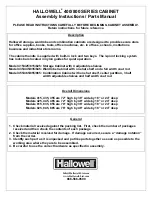
Chapter 4. IBM System Storage DS planning and configuration
105
RAID 1: For availability and good read response time
RAID 1 (Figure 4-2) is also known as
disk mirroring
. It is most suited to applications that
require high data availability, good read response times, and where cost is a secondary issue.
The response time for writes can be somewhat slower than for a single disk, depending on
the write policy. The writes can either be executed in parallel for speed or serially for safety.
Select RAID level 1 for applications with a high percentage of read operations and where cost
is not a major concern.
Figure 4-2 RAID 1
Because the data is mirrored, the capacity of the logical drive, when using RAID 1, is 50% of
the array capacity.
Here are some recommendations when using RAID 1:
Use RAID 1 for the disks that contain your operating system. It is a good choice, because
the operating system can usually fit on one disk.
Use RAID 1 for transaction logs. Typically, the database server transaction log can fit on
one disk drive. In addition, the transaction log performs mostly sequential writes. Only
rollback operations cause reads from the transaction logs. Therefore, we can achieve a
high rate of performance by isolating the transaction log on its own RAID 1 array.
Use write caching on RAID 1 arrays. Because a RAID 1 write will not complete until both
writes have been done (two disks), performance of writes can be improved by using a
write cache. When using a write cache, be sure it is battery-backed up.
RAID 3: Sequential access to large files
RAID 3 is a parallel process array mechanism, where all drives in the array operate in unison.
Similar to data striping, information that will be written to disk is split into chunks (a fixed
amount of data), and each chunk is written out to the same physical position on separate
disks (in parallel). This architecture requires parity information to be written for each stripe of
data.
Note: RAID 1 is actually implemented only as RAID 10 (see “RAID 10: Higher performance
than RAID 1” on page 108) on the DS5000 storage subsystem products.
etc.
Block 2
Block 1
Block 0
Logical Drive
Actual
device
mappings
etc.
Block 2
Block 1
Block 0
Disk 1
etc.
Block 2
Block 1
Block 0
Disk 2
Mirrorset
Host view
Summary of Contents for System Storage DS4000
Page 2: ......
Page 18: ...xvi IBM Midrange System Storage Hardware Guide...
Page 40: ...22 IBM Midrange System Storage Hardware Guide...
Page 302: ...284 IBM Midrange System Storage Hardware Guide...
Page 344: ...326 IBM Midrange System Storage Hardware Guide...
Page 372: ...354 IBM Midrange System Storage Hardware Guide Figure 7 25 Drive firmware Incompatible...
Page 490: ...472 IBM Midrange System Storage Hardware Guide...
Page 522: ...504 IBM Midrange System Storage Hardware Guide...
Page 544: ...526 IBM Midrange System Storage Hardware Guide...
Page 561: ...Index 543 Z zoning 129 130...
Page 562: ...544 IBM Midrange System Storage Hardware Guide...
Page 564: ...IBM Midrange System Storage Hardware Guide IBM Midrange System Storage Hardware Guide...
Page 565: ......
















































